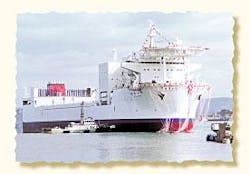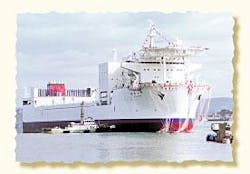Funding for basic research has shrunk in many disciplines, and so it's particularly refreshing to witness the launch of a new research initiative for scientific ocean drilling. The Integrated Ocean Drilling Program (IODP) begins on Oct. 1 and will have a 10-year initial operating period.
The principal partners, the US and Japan, signed a memorandum of cooperation to proceed, effective Apr. 22. The program is being comanaged by the US National Science Foundation (NSF) and Japan's Ministry of Education, Culture, Sport, Science, and Technology.
The European Consortium for Ocean Research Drilling (ECORD) is the management structure coordinating Europe's contribution to IODP. It includes 15 member states and involves more than 750 scientists. ECORD will support mission-specific platform operations in key areas such as ice-covered regions and shallow seas and will use a fleet of specialized drilling vessels, barges, and remote drilling systems.
Where it all began
IODP succeeds the 35-year legacy of the Deep Sea Drilling Project (DSDP) and the Ocean Drilling Program (ODP). DSDP began as an NSF-funded initiative in 1968, focused on confirming the hypothesis of seafloor spreading. Scripps Institution of Oceanography ran drilling operations using the Glomar Challenger dynamically positioned drillship, and the Joint Oceanographic Institutions for Deep Earth Sampling (JOIDES) provided scientific advice. DSDP's final leg was in 1983.
Joint Oceanographic Institutions Inc. (JOI) manages ODP, with Texas A&M University responsible for science operations and Lamont-Doherty Earth Observatory (Columbia University) responsible for logging services.
ODP began using the JOIDES Resolution, also a dynamically positioned drillship, in 1984 and has drilled at 650 sites around the world in the past 18 years. Among the many accomplishments are early research on continental rifting, investigation of the ubiquitous bottom-simulating reflector caused by natural gas hydrates, and studies on "black smokers" and massive sulfides, microbiology of deepwater sediments, and sedimentary evidence of climate fluctuation and changes in atmospheric chemistry. ODP employed new technology such as logging-while-drilling, and ODP scientists developed instrumentation for seafloor observatories to monitor and provide real-time data.
The Resolution has just completed its final ODP voyage, Leg 210, after spending 2 months drilling a 4,600 m hole off the Grand Banks east of Newfoundland. This is one of the deepest holes ever drilled in the deep ocean, penetrating nearly 2,000 m beneath the seafloor. Although this concludes the drilling phase of the program, research on ODP cores will continue.
null
Future plans
IODP is structured to run a drilling program with two or possibly three drilling platforms operating simultaneously. Using multiple platforms will allow teams to explore areas inaccessible to ODP scientists.
The US will provide a nonriser ship, akin to the JOIDES Resolution. According to JOI Pres. Steve Bohlen, the expectation is that IODP drilling will commence in June 2004, leaving only a 9 month hiatus following completion of ODP Leg 210.
The Japanese will provide a new riser ship, the Chikyu (which translates as "Earth"). The Chikyu was launched on Jan. 18, 2002, from the Tamano shipyard of Mitsui Engineering & Shipbuilding Co. in Japan (see photo). Installation of the drilling superstructure will be complete by yearend, and the ship will be ready for use in 2007-08.
New instrumentation on IODP vessels may include robotic ocean-bottom (Robo) drills, including a Robo drill mounted on a remotely operated vehicle, to core vertical or steeply dipping outcrops.
This three-platform approach thus marks the third great adventure for scientific ocean drilling.


